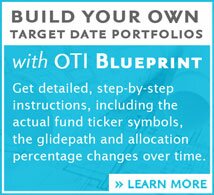|
OTI FAQs |
||||
| 1. |
|
What distinguishes the OnTarget Index (OTI) by TDA from other approaches to setting standards for target date funds? |
||
| 2. |
|
How did you decide on your asset mix and glidepath? |
||
| 3. |
|
Can you explain your “two-asset” approach in more detail? |
||
| 4. |
|
Can you explain what the “lockbox” is and how it functions in the portfolios? |
||
| 5. |
|
By stopping your roll down at the target date, aren’t you in effect abandoning participants, leaving them to fend for themselves once they reach that date? |
||
| 6. |
|
Don’t you put investors at great risk of not having enough to retire on if you deprive them of sufficient equity to grow their account balances? |
||
| 7. |
|
Given your recommendations for a more conservative approach in Current or Retirement Income Funds, how do your indexes stack up against existing retirement income (or “Current”) funds and indexes when risk and performance is measured over full market cycles? |
||
| 8. |
|
Participants don’t die at retirement; they may have another 30 or more years to go. Aren’t you ignoring the risk of running out of money when you suggest funds should have lower equity exposure? |
||
| 9. |
|
Doesn't an allocation that holds no risky assets introduce risks of its own, such as inflation erosion of your principal value? |
||
| 10. |
|
Have you entertained a measurement of the value added by the chosen glidepath? Have you compared your curved glidepath with a straight-line glidepath? |
||
| 1. |
|
What distinguishes the OnTarget Index (OTI) by TDA from other approaches to setting standards for target date funds?
The OnTarget Index(es) are distinct from other indexes and from other target date funds in a number of ways. |
||
| a. |
The OnTarget Index, a series of benchmark indexes for target date funds, is the standard for prudent target date fund design. It is the only “TO” target date fund index in the industry. OTI Objectives OTI Policies You might also say that the OTI has been successful relative to other target date indexes and funds because we stick to our core objectives; we don’t try to force the OTI to serve diverse and conflicting objectives. A portfolio model cannot simultaneously serve two dates, the target date and another date fifteen or thirty years further out. The OTI recognize the difference between the accumulation phase and the decumulation phase in the life cycle of investing. |
|||
| b. | To provide an adequate and comprehensive benchmark portfolio, our models are based on a two-asset Capital Market Line. The portfolios recreate a “world market portfolio” (WMP), comprising all assets in the world in their market weights, and combine the WMP with a “riskless” asset. (See discussion below on asset mix and glidepath.) |
|||
| c. | To match the portfolio risk with the liability and in recognition of the rapidly increasing risk to the investor as the target date approaches, we establish glidepath standards, which accelerate geometrically. |
|||
| d. | The OnTarget Indexes “de-couple” the accumulation phase from the decumulation phase. All portfolios achieve maximum protection and liquidity at the target date. This provides for meaningful benchmarking where approaches can best be aggregated—in the accumulation phase. (See the response below about stopping the glidepath at the target date.) |
|||
| e. | A “lockbox” strategy is implemented to prevent automatic adjustments (such as rebalancing) from putting more at risk than investors can afford to lose. (See the lockbox discussion below.) | |||
| 2. |
|
How did you decide on your asset mix and glidepath?
We began with Modern Portfolio Theory concepts, in particular the Capital Market Line. This line theorizes that the best mix of risky assets is the world market portfolio (WMP), comprising all assets in the world in their market weights, and that combining the WMP with a “riskless” asset dominates the efficient frontier, providing more return per unit of risk. Accordingly, we use a two-asset model: the WMP and a riskless asset. The riskless asset is designed to maintain purchasing power, i.e., to protect against inflation as well as potential nominal losses of the risky asset. The next step was establishing the glidepath, which is based on liability-driven investing (LDI). The point at which we start to apply the brakes is the longest time period over which we estimate that there is a possibility of loss in a well-diversified portfolio. Prior to this protection date, we are invested 100% in the WMP. At protection outset we calculate the amount that needs to be sheltered in reserve to assure that even if the worst-case loss occurs, the purchasing power of the current assets will be preserved. We use a “lockbox” for the reserve, which means that once assets are committed they cannot be withdrawn. As the target date draws near, a greater percentage of assets are committed to reserve (or to the lockbox) to protect against worst-case losses until, at the target date, nearly all assets are in reserve. This describes our signature Index. |
||
| 3. |
|
Can you explain your “two-asset” approach in more detail?
If you follow Modern Portfolio Theory concepts in its most theoretically sound and pragmatically tested forms, you are inexorably drawn to the Capital Market Line. This line represents the most efficient combination or “best mix” of two assets: (1) a risky asset, the world market portfolio (WMP), comprising all assets in the world in their market weights, and (2) a riskless asset. The riskless asset is often represented by Treasury bills, but other forms of riskless securities can be used. The resultant line dominates the efficient frontier, providing more return per unit of risk. Accordingly, we use a two-asset model: the WMP and a riskless asset. The risky asset serves the function of providing for portfolio growth. The riskless asset is designed to maintain purchasing power, i.e., to protect against inflation as well as potential nominal losses of the risky asset. |
||
| 4. |
|
Can you explain what the “lockbox” is and how it functions in the portfolios?
The “lockbox” we reference is simply a methodological process we undertake to ensure that those allocations to the reserve or “riskless” asset are committed to that asset. It is a one-way allocation; assets that go into the riskless asset never come out to replenish losses in the risky asset. As the target date draws near, a greater percentage of the assets are committed to the reserve asset (or “lockbox”) to protect against worst-case losses until, at the target date, nearly all assets are in reserve. |
||
| 5. |
|
By stopping your roll down at the target date, aren’t you in effect abandoning participants, leaving them to fend for themselves once they reach that date?
We believe investors have a different set of decisions in the accumulation phase than in the distribution phase, and that reliable benchmarking tools can be provided for the accumulation phase, but not for the decumulation phase. The likely uses of the funds at target date and beyond are so divergent as to render any attempt to find a single optimum strategy for all investors (and consequently any attempt to benchmark those strategies) futile. Because of the divergent investor needs at the target date, we think maximizing liquidity at target date allows all users (and their providers, advisors, etc.) to adopt their own prudent strategies. We do not stop there, however. The current development of a broad array of retirement income products is the appropriate response to a market need. We fully expect that more specific and advanced retirement income products, including a variety of annuity designs, will come to market over the coming months. In short, the needs for the accumulation phase and the decumulation phase probably cannot be well addressed by a single series of target date funds. |
||
| 6. |
|
Don’t you put investors at great risk of not having enough to retire on if you deprive them of sufficient equity to grow their account balances?
It is true that an investor with a 100% fixed income allocation over their entire accumulation phase will likely underperform a portfolio that includes some equity. Our concerns are with excessive amounts of equity in the years just before, at and after the target date. No one seriously challenges the fact that higher equity amounts carry higher risk. Risk means the possibility of loss. In the short timeframe that we’ve been tracking performance (more or less 100 years), there are periods as long as 20 years in which equities have experienced negative returns. Some advisors naively assume that if the chance of gain is higher than the chance of loss that that’s a bet worth taking, but such a bet is counter to the fiduciary responsibility of a plan sponsor and its advisors to protect the hard-won assets of all plan participants. We believe that duty is (1) to preserve the assets of the greatest possible number of participants and (2) to provide for growth without violating #1. |
||
| 7. |
|
Given your recommendations for a more conservative approach in Current or Retirement Income Funds, how do your indexes stack up against existing retirement income (or “Current”) funds and indexes when risk and performance is measured over full market cycles?
They stack up quite well. Please review the performance of the OnTarget Current Index. (“Current” meaning the target date has been reached or that the portfolio is designed to serve investors in the retirement years rather than the accumulation phase.) |
||
| 8. |
|
Participants don’t die at retirement; they may have another 30 or more years to go. Aren’t you ignoring the risk of running out of money when you suggest funds should have lower equity exposure? It is important to remember that regular withdrawals compound the volatility we call market risk, and a portfolio in withdrawal (in the decumulation phase) must be primarily positioned to preserve principal with a very low allowance for loss. Undoubtedly, many participants will reach their retirement with inadequate balances, but that problem cannot be solved with an aggressive allocation solution. |
||
| 9. |
|
Doesn't an allocation that holds no risky assets introduce risks of its own, such as inflation erosion of your principal value?
The effective and specific way of dealing with inflation is with TIPS. For that reason we include a substantial allocation of TIPS in our “Reserve Assets.” We assume investors will use their account balance at target date to fund their distribution phase. This funding may be through the purchase of annuity, or an allocation designed specifically to provide income and preservation of principal. Asset growth is no longer the primary concern, as it is in the accumulation phase. |
||
| 10. |
|
Have you entertained a measurement of the value added by the chosen glidepath? Have you compared your curved glidepath with a straight-line glidepath? We've done considerable back-testing. The geometric glidepath ensures against worst-case loss by design. As risk increases geometrically in the latter years of the accumulation phase, the risk protection increases as well. Moreover, we have undertaken (and are working on even more) considerable testing of existing funds to separate out the benefits (alpha) of a specific fund company’s asset mix from the benefits (alpha) of its glidepath. These measures are benchmarked against the appropriate OnTarget Index. |
||











